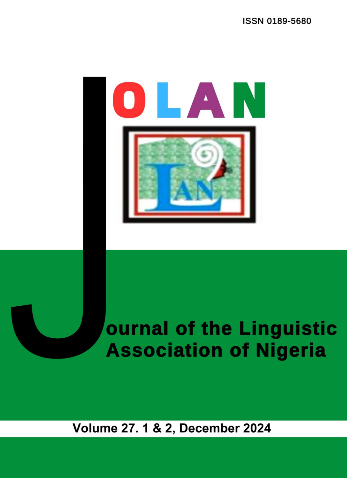Cohesive Devices in Yoruba Texts: A Study of Ó Le Kú
Keywords:
Cohesion, ellipsis, conjunction, reference, cohesive devicesAbstract
Cohesion is a relation that occurs on the semantic level of communication which links sentential elements together into a unified whole. There are several cohesive relations that link the sentences into a text. The essence of this study is to examine the extent to which Halliday and Hasan (1976) model of cohesion (precisely cohesive devices) is used to achieve unity, meaning, understanding and readability in Yoruba literary texts, using Ó le kú as a case-study. Ó le kú is a prose text written by Akinwumi Isola, a renowned Yoruba literary artist. The data for the study consisted of Yoruba sentences selected from the novel. The data was extracted from the novel by reading through the text severally to note the different types of cohesive devices used by the author and their effect on the interpretation of the text. The paper investigates the extent to which the author of Ó le kú uses the textual resources of cohesion and cohesive devices to link ideas in the sentences used in the text and examines the effect that the cohesive devices used have on the quality of message passed across in the novel. In this paper, we deal with reference, ellipsis and conjunction. These mechanisms of cohesion, common to all languages, make a series of sentences coherent, so they do not seem to occur randomly. The purpose of ellipsis and reference is to avoid the burdening repetitions within the text, and to make the whole text cohere. Coordinating conjunctions were used as joining or linking devices in the text. The author based on the outcome of the study used intermixed styles to convey his message to the readers.
References
Abba, A. (2003). History of Yola (1809-1914). Zaria. Ahmadu Bello University Press.
Ahmed, A, I. (2011). Introduction to Fulfulde Syntax. LINCOM EUROPA, Academic Publications.
Aminu, A. (2015). Comparative Study of Hausa and Fulfulde Inflections. Unpublished M.A Thesis. Zaria. Department of African Languages and Cultures, Ahmadu Bello University.
Aminu, A. (2016). Comparative Study of Fulfulde and Swahili Noun Classes. Kano. 2nd International Conference on Fulfulde Studies. Centre for Research in Nigerian Languages and Folklore, Bayero University, Kano.
Arnott, D.W. (1956). The Middle Voice in Fula. Bulleting of the School of Oriental and African Studies, University of London, Vol. 18 No. 1. Cambridge University Press.
Arnott, D.W. (1970). Nominal and Verbal Systems of Fula. Oxford. Clarendon press.
Arnott, D.W. (1974). Some Aspects of the Study of Fula Dialects. London. Bulleting of the School of Oriental and African Studies. Vol. 37, No 1. Cambridge University Press.
Daudu, G.K. (2008). Morphological Processes in Fulfulde, Harsunan Nijeriya.
Girei, A.U. (1999). A Comparative Analysis of Morphosyntactic Variations Between Adamawa and Gombe Dialects of Fulfulde. M.A Thesis, Department of Languages and Linguistics, University of Maiduguri, Nigeria.
Goshe, S.M. (2016). The Lexical Dialectal Variations Between Sokoto and Adamawa Dialect of Fulfulde Language. Kano. 2nd International Conference on Fulfulde Studies. Centre for Research in Nigerian Languages and Folklore, Bayero University, Kano.
Greenberg, J.H (1963). The Languages of Africa. Indiana University, Bloomington, Mouton, The Hague.
Labov, W. (2007). Transmission and Diffusion. Language, vol.8 no 2. Linguistic Society of America. Stable URL:
http://www.jstor.org/stable/40070845
Lyons, J. (2009). Language and Linguistics. Cambridge. Cambridge University Press.
McIntosh, M. (1984). Fulfulde Syntax and Verbal Morphology. St Edmundsbury Press Ltd.
Mukoshy, I. (1991). Fulfulde Morphemes. In: Abba, I.A. Mukoshy, I. and Tahir, G. (Eds) Studies in Fulfulde Language, Literature and Culture, Proceedings of the 1st – 4th International Conferences on Fulfulde Language, Literature and Culture. Kano: Centre for the Study of Nigerian Languages, Bayero University.
Mukoshy, I. A. (1984). The sounds and Morphemes of Fulfulde: An Examination of Fulfulde Phonology and Morphology. Unpublished. PhD Dissertation. Khartoum: Institute of African and Asian Studies, University of Khartoum.
Pelletier, C. A. and Skinner, A. N. (1981). Adamawa Fulfulde: An Introductory course. Department of African languages and Literature. Madison: University of Wisconsin-Madison.
Usman, B. Bello, M.I, Muhammad, A.A. (2016). The Emerging Variety of Adamawa Dialect of Fulfulde. Kano. 2nd International Conference on Fulfulde Studies. Centre for Research in Nigerian Languages and Folklore, Bayero University, Kano.
Yule, G. (1991) The Study of Language. Cambridge. The Bath Press Avon.














